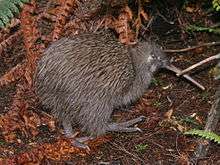Fiordland penguin
| Fiordland penguin | |
|---|---|
.jpg) | |
| Scientific classification | |
| Kingdom: | Animalia |
| Phylum: | Chordata |
| Class: | Aves |
| Order: | Sphenisciformes |
| Family: | Spheniscidae |
| Genus: | Eudyptes |
| Species: | E. pachyrhynchus |
| Binomial name | |
| Eudyptes pachyrhynchus G. R. Gray, 1845 | |
 | |
| Distribution of the Fiordland penguin | |
The Fiordland crested penguin (Eudyptes pachyrhynchus), also known as tawaki (Maori), is a species of crested penguin from New Zealand. It breeds along the south-western coasts of New Zealand's South Island well as on Stewart Island/Rakiura and its outlying islands.[2]
Taxonomy
Also known as the Fiordland crested penguin, the Fiordland penguin was described in 1845 by English zoologist George Robert Gray, its specific epithet derived from the Ancient Greek pachy-/παχυ- "thick" and rhynchos/ρύγχος "beak".[3] It is one of six species in the genus Eudyptes, the generic name derived from the Ancient Greek eu/ευ "good" and dyptes/δύπτης "diver".[3]
Description
They are medium-sized, yellow-crested, black-and-white penguins, growing to approximately 60 cm (24 in) long and weighing on average 3.7 kg (8.2 lb), with a weight range of 2 to 5.95 kg (4.4 to 13.1 lb).[4] It has dark, bluish-grey upperparts with a darker head, and white underparts. It has a broad, yellow eyebrow-stripe which extends over the eye and drops down the neck. Most birds have three to six whitish stripes on the face.
Distribution and habitat
This penguin nests in colonies in dense temperate forest. It breeds along the shores of Southwestland, Fiordland and Stewart Island/Rakiura and its outlying islands.
Diet
The main prey species reported for Fiordland penguins are cephalopods (85%, mainly arrow squid, Nototodarus sloanii), followed by crustaceans (13%, primarily krill, Nyctiphanes australis) and fish (2%, mainly red cod and hoki). However, the importance of cephalopods might be exaggerated.[5]
Conservation
The current status of this penguin is threatened due to its small population. Current population estimates range between 2,500–3,000 pairs although this is believed to be an underestimate of the true population size. The population at some sites reportedly underwent declines while at others penguin numbers apparently increased; overall population trends remain unclear.[2] It is under threat from introduced predators including dogs, cats, stoats and rats.
References
- ↑ BirdLife International (2012). "Eudyptes pachyrhynchus". IUCN Red List of Threatened Species. Version 2013.2. International Union for Conservation of Nature. Retrieved 26 November 2013.
- 1 2 Mattern, Thomas (2013). "Chapter 10: Fiordland penguin Eudyptes Pachyrhynchus". In Garcia-Borboroglu, Pablo & Boersma, P. Dee. Penguins: Natural History and Conservation. University of Washington Presss. pp. 152–167. ISBN 978-0-295-99284-6.
- 1 2 Liddell, Henry George & Robert Scott (1980). A Greek-English Lexicon (Abridged Edition). United Kingdom: Oxford University Press. ISBN 0-19-910207-4.
- ↑ CRC Handbook of Avian Body Masses by John B. Dunning Jr. (Editor). CRC Press (1992), ISBN 978-0-8493-4258-5.
- ↑ van Heezik, Y: Diet of the Fiordland Crested penguin during the post-guard phase of chick growth, Notornis 36: 151-156 (1989)
External links
- The Tawaki Project - Current research project on Fiordland penguins
- Fiordland penguins at Penguins in New Zealand
- Fiordland penguins from the International Penguin Conservation website
- Penguin World: Fiordland penguin
- www.pinguins.info information about all species of penguins
- Roscoe, R. "Fiordland Crested Penguin". Photo Volcaniaca. Retrieved 13 April 2008.
- Fiordland penguin - www.penguins.com.au

